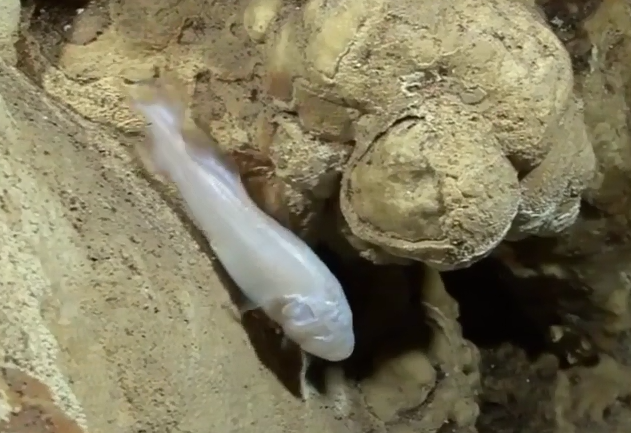Since I have never seen one, I'm not exactly sure what to look for!
因为我没有见过这种鱼,所以我不知道该找什么!
I'm surprised to see what looks like a bush growing in the pitch darkness of the cave.
我很惊讶地看到在黑暗的山洞里长着一丛灌木。
But it's actually the roots of a tree living in the jungle up above. The trees up there have no problem getting plenty of water!
但它实际上是一棵树的根,这棵树生活在上面的丛林中。树木有充足的水源!
Christine is hunting in the tangled maze of roots. Sometimes the cavefish hide in there.
克里斯汀在错综复杂的树根中寻找,有时,洞穴鱼会躲在里面。
I can't help but notice that there is air above my head! This cave actually has some very large air pockets.
我不禁注意到头顶上方有空气!这个洞穴实际上有非常大的气孔。
Since they are connected to the surface through tiny cracks, the air is safe to breathe, so I stick my head up and take a look around.
由于它们通过微小的裂缝与地面相连,可以放心地呼吸这里的空气,所以我抬起头四处看下。
There are more stalactites above water. Because these are in air, they are still growing.
水面上还有更多的钟乳石,因为这些长在空气中,所以它们还在生长。
On the bottom, Christine points out some extremely thin and fragile flakes of calcium. This forms as a film on the surface of the water below dripping stalactites.
在洞底,克里斯汀指给我看一些易碎的薄钙片,这是滴水的钟乳石在水面上形成的一层薄膜。
When it gets thick enough, it sinks to the bottom. In some places, the flakes are stacked up several inches thick.
当它变厚后,就会沉到洞底。在某些地方,薄片堆积起来有几英寸厚。
This little pile is hundreds of years worth.
要形成这么一小堆需要几百年的时间。
As I continue looking for the cavefish, I stumble across a jawbone from some kind of animal that walked in here and died a long time ago when it was dry.
我继续寻找洞穴鱼的时候,偶然发现了一个动物的颌骨,这只动物走到这里后死在了这儿,这发生在很久以前,那时洞穴里还没有水。
This has to be thousands of years old but it is in amazingly good condition.
它一定有几千年的历史了,但是保存地非常完好。
Skittering across the sand I find a cave shrimp. This species is not blind—but moves between the dark and light portions of the cave. It probably feeds on organic material that originates with the tree roots.
我在沙面上掠过时,发现了一只洞穴虾。它能看到东西,在洞穴的黑暗处和光亮处之间游动。它可能以来自树根的有机物质为食。
Life is tough in the darkness. This is a catfish that couldn't find its way out.
在黑暗中生活是艰难的,这是一条找不到出口的鲶鱼。
Christine searches for another mass of tree roots that might harbor a cavefish.
克里斯汀在寻找另一片可能藏有洞穴鱼的树根。
When we find one, I start looking carefully in the roots. At last I spot it! A pinkish white fish hiding in there! It's great to see, but impossible to film in that tangled mess.
当我们找到一片时,我开始仔细查看根部。我终于看到了!一条粉白色的鱼藏在里面!能看到它真是太棒了,但在一片树根中很难拍摄清楚。
Fortunately for me, the fish shies away from light and swims out of the roots.
幸运的是,鱼躲避灯光,从根部游了出来。

Even though this species of fish has evolved for thousands of years in the complete absence of light and has no eyes, it can still detect the presence of light through its albino skin using a gland in its head.
尽管这种鱼在完全没有光和眼睛的情况下进化了数千年,但它仍然可以利用头部的腺体感受到透过白化皮肤的光线。
Why? This fish's only defense is darkness. If it wanders out of the dark part of the cave, other fish can see it—but it won't see them. The blind cavefish needs to stay in the dark where it's safe.
为什么呢?因为这种鱼唯一的防御方式就是黑暗。如果它游出洞穴的暗处,其他鱼可以看到它,但它看不到它们。所以,盲鱼需要呆在暗处,它们在那是安全的。
My lights make the cavefish swim for cover and safety. The fish that followed me into the cave from outside take an interest in the cavefish. I have to shoo them away.
我的灯光让洞穴鱼游动去寻找安全的掩护地,从外面跟我游进洞中的鱼对它很感兴趣。我得把它们赶走。
Although life is sparse in the cave with very few animals able to survive in the darkness, the cavefish does manage to hunt down tiny crustaceans and worms that also make this their home.
尽管洞穴中的生命稀少,只有很少的动物能在黑暗中生存,但洞穴鱼设法捕捉到那些也把这里当作自己家的微小的甲壳类动物和蠕虫。
In fact, in the cave ecosystem, this little fish is the top predator—the great white shark if you will of the cave.
事实上,在洞穴生态系统中,这种小鱼是顶阶捕食者,它就好像是这个洞穴里的大白鲨。
With our mission complete, it's time for me and Christine to turn around and head back out to the light. Christine knows this cave like the back of her hand, but for added safety, we follow a line.
完成任务后,我和克里斯汀掉头游回到光亮的地方。克里斯汀对这个洞穴了如指掌,但为了更加安全些,我们还是沿着一条线往回游。
On the line are little plastic triangular arrows that point the way out.
这条线上系着一些塑料制成的三角形小箭头,它们指向洞穴的入口处。
We could use these in complete darkness by feeling them and holding on to the line the whole way.
我们通过触摸它们,可以在一片漆黑中沿着这条线一路游出来。
Christine stops to point out an amazing type of stalactite.
克里斯汀停下来,指给我看一种令人惊奇的钟乳石。
Unlike most stalactites, which look more like icicles, these unique formations look like elephants feet, with bulbs instead of points on the end.
它们和大多数看起来像冰柱的钟乳石不一样,这些钟乳石形状独特,看起来像大象的脚,末端不是尖的而是球状形。
They are formed when the cave is partially filled with water and the stalactite grows from above, eventually reaching the water.
当洞穴中有一部分充满水,钟乳石从上方生长,最终到达水面时,便形成这样的钟乳石。
Once the stalactite touches the water, it flattens out. As the water level changes, bulbs form at different levels.
一旦钟乳石接触到水面,就会变平。随着水位的变化,会在不同的水位线上形成球状物。
Finally we are nearing the cenote entrance and we head back into the light.
我们终于接近了天坑的入口处,回到了光明的地方。
Christine explores the cenote just under the surface, before we head back to the steps to get out of the water.
克里斯汀在我们回到台阶离开洞水之前,在水下四处查看了这个天坑。
Wow, that is such a beautiful cenote! All the formations hanging down and everything!
哇,这真是一个美丽的天坑!那些挂在洞顶的钟乳石!
That was great!
真是太棒了!
It's hard to believe that there is an entire world living under the jungle in a submerged cave, but life survives everywhere in the blue world, even in complete darkness.
很难相信,在丛林下浸满水的洞穴中还有这样一个世界,但在蓝色世界的任何地方都有生命存在,即使在一片漆黑中依然如此。












